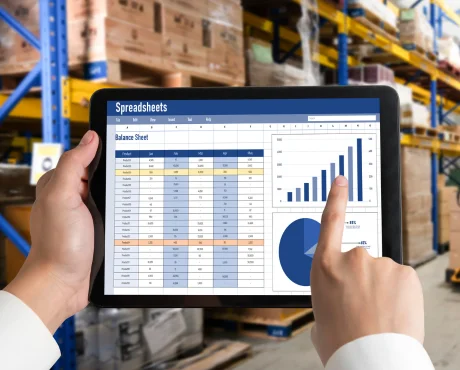For years, manufacturers have been using old methods to estimate the product manufacturing cost. These ways worked fine when things were more stable and we couldn’t get data in real-time. But now, with tech moving fast and supply chains getting more complex worldwide, these old tricks aren’t working so well. Today’s factories need to be quick on their feet, super accurate, and know what’s happening right now – something the old ways of guessing costs can’t do. Let’s look at why these older cost estimation methods don’t work in manufacturing anymore and how new tools are stepping up to help.
Challenges With Traditional Cost Estimation Methods in Manufacturing
Selecting the best manufacturing software isn’t just about finding a tool that works-it’s about finding the right tool that works for your business. A piece of software that suits a small-scale, single-product manufacturer may not work for a large enterprise with multiple lines, complex supply chains, and global operations.
Similarly, not all cost estimation tools are created equal. Some may offer deep, granular features for large manufacturers, while others might be simpler but more user-friendly for smaller teams.
The risks of rushing into a decision can be significant. The wrong software can lead to inaccurate estimates, inefficient workflows, and frustration among your team. Worse yet, investing in the wrong solution can result in unexpected costs or force you into an expensive migration process later.
However, many systems have overlapping features, making things complicated. We’ve sorted through the noise to help you focus on the essentials.
1. Historical Cost Calculation
What it is:
Estimating historical costs means guessing future production expenses using data from earlier production runs. Material costs, worker pay, and how much was made in past jobs help predict future expenses. This approach assumes that future costs will follow past patterns.
The Problem With This Method
Historical data has value but it doesn’t consider how manufacturing changes today. For example, if steel costs jump almost 50% worldwide due to supply chain problems and more demand from car makers and builders, a manufacturer using old data will have to bear more cost.
Their cost guesses would have been way off. Also, you need different cost structures when you bring in new products or materials, those using cutting-edge tech like 3D printing. Past cost estimation methods can’t predict these.
Another downside is that older methods don’t account for better production efficiency or automation. Take a manufacturer who switches to robot automation. They might see their labor costs go down and their accuracy go up, but these shifts won’t appear in the old data unless someone keeps track of them.
2. Direct Labor and Material Costing (Job Order Costing)

What it is:
Also known as job order costing, this method calculates direct labor, material, and overhead costs for each job or production batch. It’s often used in industries where each order is unique.
The Problem with This Method:
- Ignore indirect costs: While it accounts for direct costs, job order costing doesn’t capture indirect costs like maintenance, utilities, or administrative overhead, leading to inaccurate cost estimates.
- Manual and error-prone: Tracking each job individually is time-consuming and prone to mistakes, especially in high volumes.
- Not scalable: As a business grows, managing job order costing becomes more difficult and inefficient, especially when dealing with larger production volumes.
3. Standard Costing
What it is:
Standard costing assigns a fixed cost to each unit based on materials, labor, and overhead estimates. Actual costs are compared to these standard costs, and variances are investigated.
The Problem with This Method:
- Too rigid for change: Standard costing relies on a set cost structure that doesn’t quickly adjust to fluctuations in production conditions, like changes in material prices or labor efficiency.
- Misleading variances: Variances between actual and standard costs can sometimes lead to confusion. Small deviations are normal, while more significant issues go unnoticed.
- Lack of real-time insights: Standard costing offers no flexibility for making real-time adjustments based on new data, resulting in outdated cost information that can lead to poor decision-making.
4. Activity-Based Costing (ABC)
What it is:
Activity-based costing assigns costs based on activities that consume resources, like machine setups, inspections, and packaging. It provides a more detailed allocation of overhead costs compared to traditional methods.
The Problem with This Method:
- Highly complex and resource-draining: Setting up and maintaining an ABC system requires extensive data collection, making it challenging for smaller companies without robust data management systems.
- Inflexible: While ABC offers detailed insights into cost drivers, it doesn’t easily adapt to changes in production schedules or resource availability, making it less useful in dynamic manufacturing
5. Volume-Based Costing (Unit Costing)

What it is:
Volume-based costing is the ratio of the total production costs and the number of units produced to calculate the cost of a single unit. This method is best for industries with high-volume production of identical or nearly identical products.
The Problem with This Method:
- Not suited for diverse products: Volume-based costing assumes all products are identical, which isn’t the case for custom or varied product lines, leading to inaccurate cost estimations.
- Ignore important fixed costs: This method overlooks essential fixed costs, such as equipment depreciation or facility maintenance, which are crucial for accurately understanding total production costs.
- Missed efficiencies: Volume-based costing doesn’t capture cost-saving opportunities from economies of scale, giving businesses a less accurate picture of their production costs.
6. Absorption Costing
What it is:
Absorption costing uses direct and indirect costs of the product, incorporating fixed costs like rent and utilities alongside variable costs such as labor and materials. It’s often used for external financial reporting.
The Problem with This Method:
- Distorted cost information: Absorption costing can assign fixed costs to products that aren’t directly related to production, leading to misleading cost data that skew pricing and profitability decisions.
- Slow to respond to changes: Just like other traditional methods, absorption costing is slow to adjust to rapid changes in market conditions or production variables, which can result in outdated and inaccurate cost estimates.
- Unclear profitability: By spreading fixed costs across all products, absorption costing can overstate the profitability of low-volume products, making it difficult to assess which products are truly profitable accurately.
Wrapping Up: A Shift Toward Modern Solutions
While traditional cost estimation methods in manufacturing served their purpose in the past, they no longer meet the needs of today’s fast-paced, technology-driven manufacturing environment. Inability to adapt quickly to changes, oversimplifications, and failure to account for all relevant costs are a few challenges that manufacturers may encounter using old methods. They do not give real-time insights which are important for data-driven decisions.
The future of cost estimation in manufacturing lies in modern tools and technologies. AI-based cost estimation tools, machine learning algorithms, and integrated ERP systems offer manufacturers the flexibility and real-time data they need to optimize their processes.
Embracing these advanced technologies can help manufacturers tackle complex cost estimation challenges, providing more accurate and actionable insights for improved decision-making and machining cost calculation.





